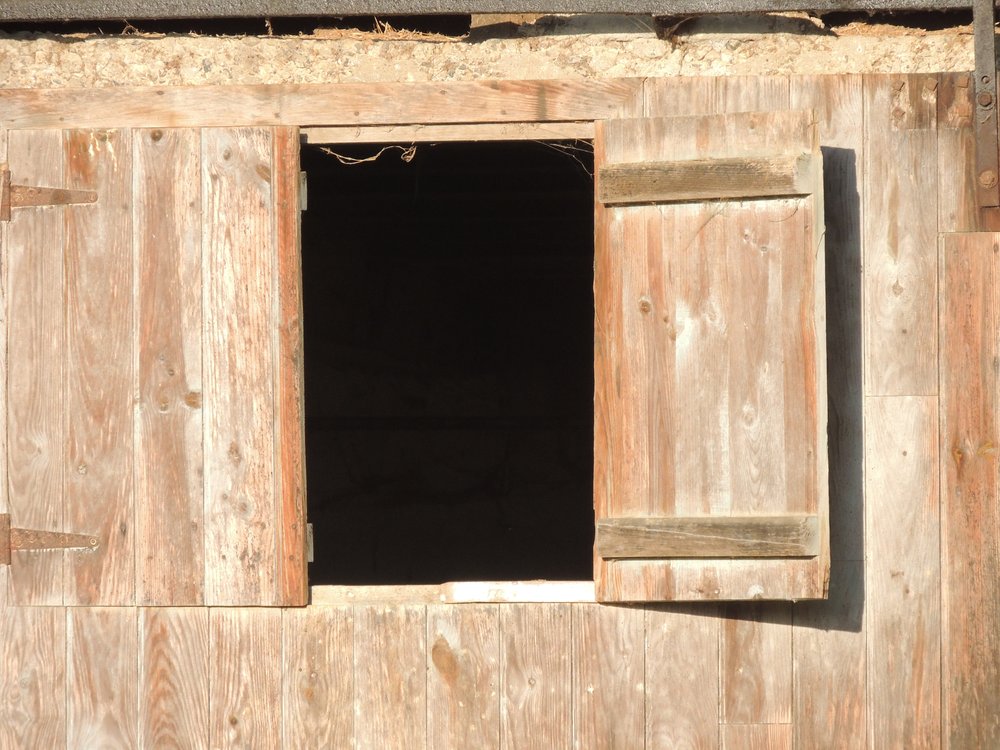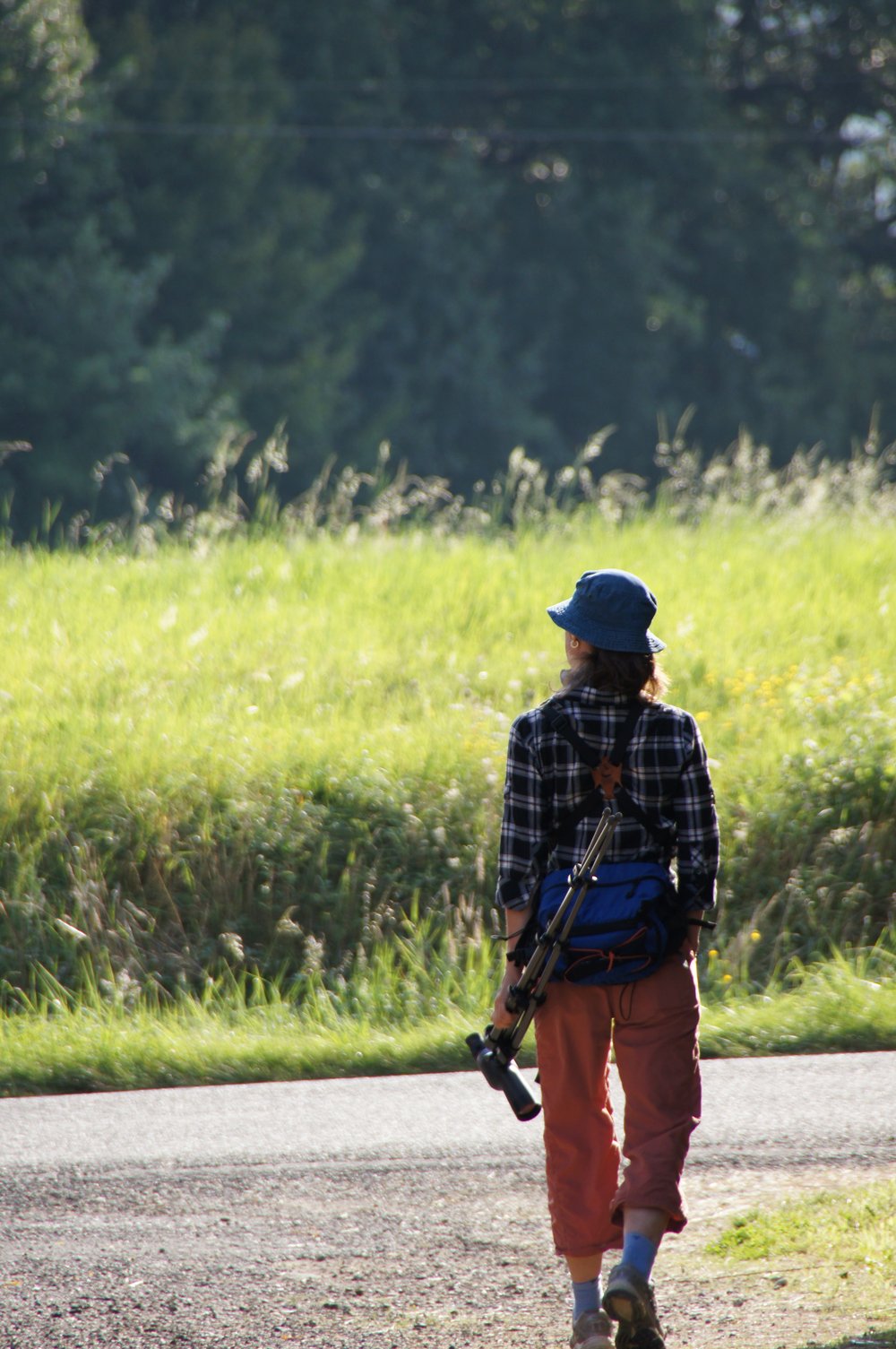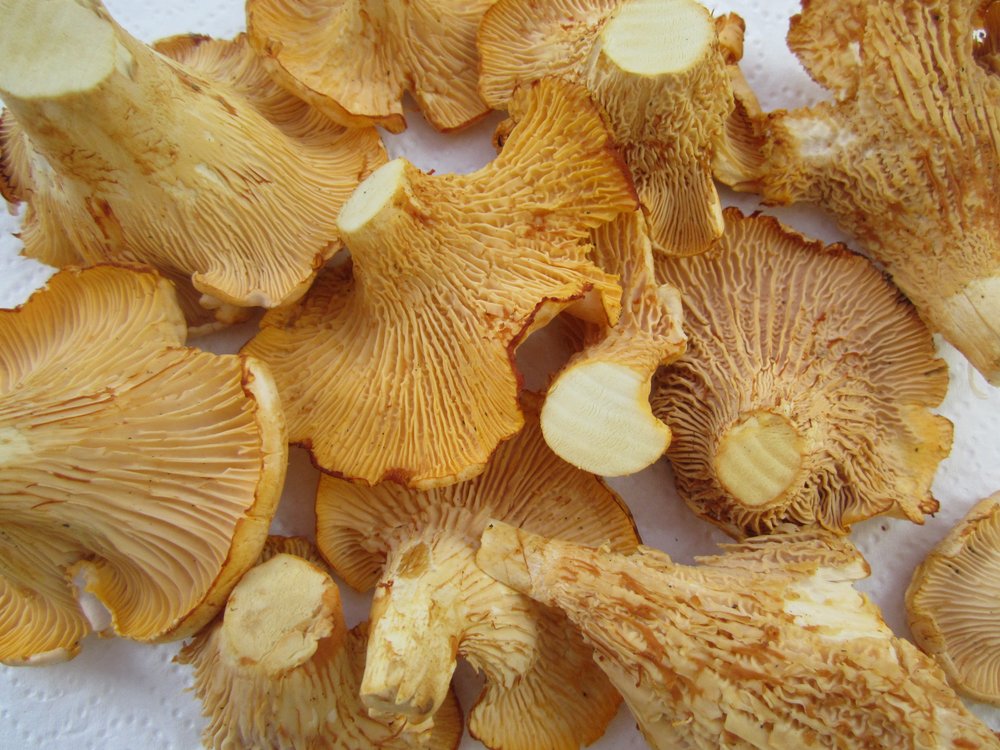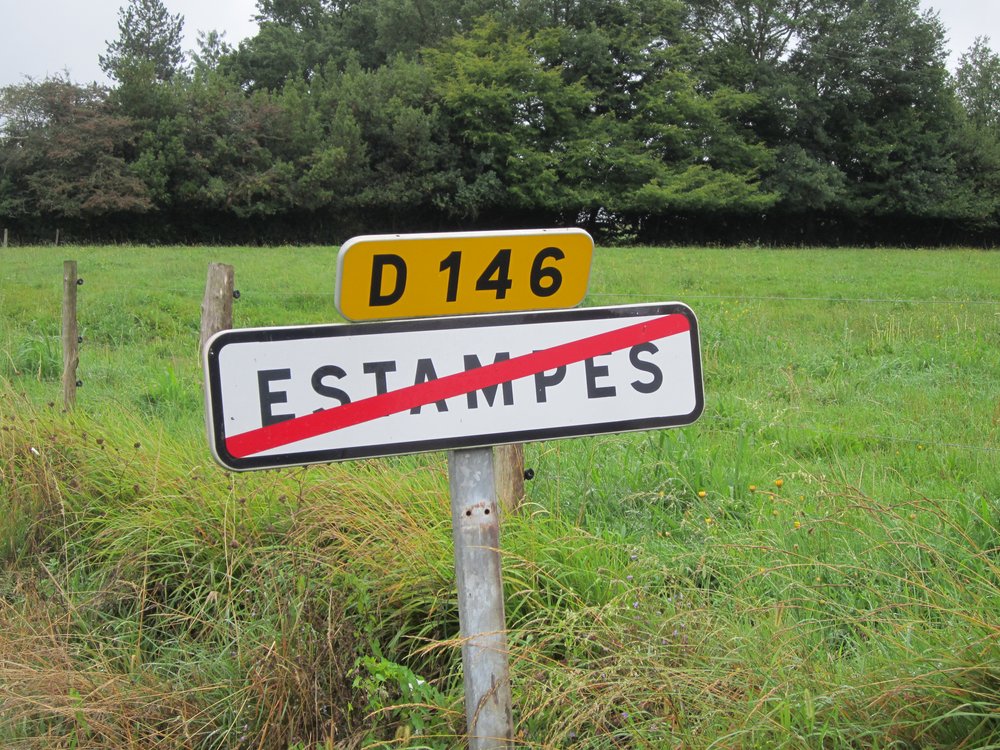Hirondelle

As we step into the barn to put down hay for the sheep, a barn swallow swoops through the open door. Swallows, with their white bellies and long forked tails are obvious all day long as they wing about chattering in elegant loops and dives. Inside the dark barn a dozen mud-formed nests cling to the wooden rafters. Strings of straw dangle from cobwebs nearby in this nearly abandoned barn. The space between nest and the ceiling is narrow—just enough for a swallow head.

As we step into the barn to put down hay for the sheep, a barn swallow swoops through the open door. Swallows, with their white bellies and long forked tails are obvious all day long as they wing about chattering in elegant loops and dives. Inside the dark barn a dozen mud-formed nests cling to the wooden rafters. Strings of straw dangle from cobwebs nearby in this nearly abandoned barn. The space between nest and the ceiling is narrow—just enough for a swallow head.

She can’t explain it, but the swallows are dying. She’s not the only one to notice this. Genevieve, the local baker, tells me she doesn’t see swallows anymore. There are ten swallows in the village, Claude tells me. They all guess at what is wrong: the fertilizers on the fields, perhaps. They all shrug: who knows. There are a lot of mysteries in the farming life. This is one more.
Odette and I look about the barn. Under two nests are bird droppings, a sign that someone has taken up residence. “Maybe there will be young,” she says, hopeful.
The next morning as I quietly go about playing farmer, then I check on the nests. There’s a swallow on one, her body covering the opening of the mud structure. When I look closely, I see a little beak poking out the side. I slide the barn door shut, leaving her to her swallow business.

Through the day, they use our courtyard as a place to hang out, to practice flying and to beg for food. From time to time an adult swoops in and satisfies that need, but most of the time they are on their own.
Later that night, I return to the barn and tell Odette about the baby swallows. The news cheers her. I peer in at the nests and see that the young have all returned to the safety of the barn for the night.

Leaving Estampes

We drive south toward Trie. Our drive in the coming light reminds me of when I drove this route with Stanis back in the mid-eighties. Then, Trie called itself the largest pig market in the world; we were hauling a pig to market. We drove in Stanis’ small white Peugeot without speaking, Stanis tugging on a cigarette, his beret pulled down on his forehead. We made our up the winding hillside above Estampures, then shot down the main road into Trie. Selling the pig lasted less than three minutes—there was some conversation spoken in Patois, a shake of hands, and we walked off. By 7:30 in the morning we were in the local bar, filled with peasant farmers all dressed in black or blue pants, berets over their ruddy faces. Stanis ordered a glass of wine; I had some coffee.
On this morning, I have my scope at the ready, my binoculars poised. We are heading toward the lac Puydarieux. Neighbors told us about the lake—that it is a birding spot—just the night before. So though it’s my second to last day in Estampes, I want to see this spot. We turn toward Castelneau Magnoac and after missing the turn to the lake arrive a little after seven. There’s an information board with an impressive list of birds seen in the past week, included a booted eagle, a hobby, black and royal kites, and purple herons. I practically run to the lake. The first bird I see floating on the dammed lake is a great crested grebe, with a striped black and white baby begging and bobbing beside it. The lake is littered with birds, mostly mallards. But there are plenty of horned grebe, grey herons, coots, and gulls, which I can’t identify. We walk the edge of the lake, then across the dam as two men launch a boat to fish. I spy cormorant and teal, and then, to my delight, a hobby with its sharp elbows flies overhead (hobby in French is Faucon Hobereau, I learn). I find Lisa sitting on the dam, her camera to her eye, photographing flowers and dandelions and contemplating how she can capture the feel of this special spot we have found.

We drive south toward Trie. Our drive in the coming light reminds me of when I drove this route with Stanis back in the mid-eighties. Then, Trie called itself the largest pig market in the world; we were hauling a pig to market. We drove in Stanis’ small white Peugeot without speaking, Stanis tugging on a cigarette, his beret pulled down on his forehead. We made our up the winding hillside above Estampures, then shot down the main road into Trie. Selling the pig lasted less than three minutes—there was some conversation spoken in Patois, a shake of hands, and we walked off. By 7:30 in the morning we were in the local bar, filled with peasant farmers all dressed in black or blue pants, berets over their ruddy faces. Stanis ordered a glass of wine; I had some coffee.
On this morning, I have my scope at the ready, my binoculars poised. We are heading toward the lac Puydarieux. Neighbors told us about the lake—that it is a birding spot—just the night before. So though it’s my second to last day in Estampes, I want to see this spot. We turn toward Castelneau Magnoac and after missing the turn to the lake arrive a little after seven. There’s an information board with an impressive list of birds seen in the past week, included a booted eagle, a hobby, black and royal kites, and purple herons. I practically run to the lake. The first bird I see floating on the dammed lake is a great crested grebe, with a striped black and white baby begging and bobbing beside it. The lake is littered with birds, mostly mallards. But there are plenty of horned grebe, grey herons, coots, and gulls, which I can’t identify. We walk the edge of the lake, then across the dam as two men launch a boat to fish. I spy cormorant and teal, and then, to my delight, a hobby with its sharp elbows flies overhead (hobby in French is Faucon Hobereau, I learn). I find Lisa sitting on the dam, her camera to her eye, photographing flowers and dandelions and contemplating how she can capture the feel of this special spot we have found.

There are much more scenic views of the water, and some lapwings at a pull out on the southern end. We stand for a long time, looking and photographing the herons, the cattle egret, some lapwings working the shore and another shorebird I can’t identify (if I were at home I’d say yellowlegs, but I’m not sure here). Then we make a dash toward Mirande, where it is the marche, market day.

Lisa and I find strawberries, very ripe reine claude, the small green plums that are all sugar, white peaches, two kinds of gorgeous tomatoes, and then a runny sheep’s milk cheese that makes us happy. The whole day makes me happy in detail—the birds, the beautiful lake, the fresh fruits and vegetables, the company of my cousin. But lurking is the knowledge that I’m leaving tomorrow, and so every gesture, every plum eaten, every view, every bird seen is tinged with a faint melancholy.
Green Woodpecker, Estampes
 Green woodpeckers are common in France. But not so common that I’ve been able to see one in the ten days that I have been here. And I want to see one. Something about woodpeckers I find fascinating, and the names help. When I saw a three toed woodpecker (really, three toes?) in Maine, I was thrilled. When this past Christmas Peter and I saw a black woodpecker in the forest of Fontainbleau outside of Paris it was the highlight of the trip (not, as some might think, visiting Notre Dame…). So a green woodpecker was my goal for the morning as I rose at 6—the world still dark and quiet—and was out before seven. I walked south out of town, a winter wren singing to me from a bush that has taken over the courtyard of the abandoned house that once belonged to Francine. In the freshly cut field to one side I see a fox trotting my way. It’s tail is thick, a dark red, lined with brown. It doesn’t see me, so I stand still, and watch. I can tell what route it intends to take, out of the field, across the road and into the corn. So I pull out my camera and wait until it is mid-road. As I snap the photo, he becomes aware I am there, and picks up his pace as he moves into the corn and vanishes so fast.
Green woodpeckers are common in France. But not so common that I’ve been able to see one in the ten days that I have been here. And I want to see one. Something about woodpeckers I find fascinating, and the names help. When I saw a three toed woodpecker (really, three toes?) in Maine, I was thrilled. When this past Christmas Peter and I saw a black woodpecker in the forest of Fontainbleau outside of Paris it was the highlight of the trip (not, as some might think, visiting Notre Dame…). So a green woodpecker was my goal for the morning as I rose at 6—the world still dark and quiet—and was out before seven. I walked south out of town, a winter wren singing to me from a bush that has taken over the courtyard of the abandoned house that once belonged to Francine. In the freshly cut field to one side I see a fox trotting my way. It’s tail is thick, a dark red, lined with brown. It doesn’t see me, so I stand still, and watch. I can tell what route it intends to take, out of the field, across the road and into the corn. So I pull out my camera and wait until it is mid-road. As I snap the photo, he becomes aware I am there, and picks up his pace as he moves into the corn and vanishes so fast.
The sun pops over the hills on the eastern end of the valley and the world is washed in light. The fields of sunflowers and corn look magical, bright. I hear the cackle of woodpeckers in the far woods. As I make my way there, I hear a gunshot from the same woods. It is not any hunting season so I decide that may not be the place to walk. Still, I loiter about on the bridge that separates the Gers from the Haute Pyrenees, visiting with a great tit, and some red tails.

And here’s the strange thing: by the end of the day I will see five of these green woodpeckers. The question is, were they around all the time and I simply did not see them? Or, have they emerged? I think probably the former, how knowing what to look for triggers something in our minds so that we can see it again. I remember when I first followed the call of the great crested flycatcher to find the bird sallying at the top of a tree. After that moment, I heard and saw flycatchers every day, and a bird I did not know, seemed suddenly a common bird.
I loop up the hill, taking the long way home, and another woodpecker screams overhead, landing in a nearby tree. Also green! I feel as if I have conjured these birds.
I walk the same path I walked last night. It was the full moon, the Sturgeon Moon. At home, I always paddle out into the night on the full moon, and the Sturgeon Moon is my favorite (yes, there’s a chapter in my book devoted to the somewhat hallucinatory experience of paddling the full moon). So a walk through the village would have to substitute for my watery ramblings. The moon shone down, illuminating the rough road, but not bright enough that I could find the owl calling from behind a crumbling house.

I wonder when Odette, now 82, will stop tending to her chickens. Last night as we sat outside in the courtyard and ate our dinner of duck confit made by Odette we were all aware that this was the last time we would eat this rich, dense meat. The days of raising ducks, of feeding them corn, then making foie gras and confit are over. It’s just too much work.
One winter I was living in the house and would hover in the barn while Odette fed her ducks. It was an odd, loving process. She would place the duck in a box, its neck sticking out. Then she’d straddle the box and take the duck’s neck in her hands (vegetarians can just skip the rest of this account). She’d talk to the duck, massaging its neck. Then she would insert a long funnel, and grind the corn that would fall directly into the duck’s stomach. In this way, it fattened beyond what is natural. Any stress or abrupt motions might break the duck’s neck. So Odette’s movements were gentle, tender.
That was the case as she stuck the chicken into its cage to relearn its relationship with eggs. She spoke to the bird, reminding it to drink water, to be well.
Wood Doves

The dirt path is bumpy and barely used by farmers coming to cut wood. A few open fields deep in the woods are used to graze cattle. The woods are filled with chestnut trees, the green spiny fruit dangling, beech trees, some holly. The land in the woods is often terraced, a reminder that this region was mostly vineyards until phylloxera destroyed the vines in the late nineteenth century.
Near the house that is now owned by two Dutch women, we turned right. The day before we had visited the women, who have set up shop to make cheese here in this isolated patch of French soil. We had heard of these two for the ten years since they moved in—that they are Dutch is a novelty in an area where the British have come to settle. But more, that they are a couple has pretty much everyone talking. “We’ve seen everything here in Estampes,” Odette says clapping her hands and laughing. But newcomers to the area are scrutinized. Odette knows this as her husband Stanis, came from Polish stock: Baczkowski. She was ostracized from her family for marrying a Pole, who was more French than some Frenchmen.

The dirt path is bumpy and barely used by farmers coming to cut wood. A few open fields deep in the woods are used to graze cattle. The woods are filled with chestnut trees, the green spiny fruit dangling, beech trees, some holly. The land in the woods is often terraced, a reminder that this region was mostly vineyards until phylloxera destroyed the vines in the late nineteenth century.
Near the house that is now owned by two Dutch women, we turned right. The day before we had visited the women, who have set up shop to make cheese here in this isolated patch of French soil. We had heard of these two for the ten years since they moved in—that they are Dutch is a novelty in an area where the British have come to settle. But more, that they are a couple has pretty much everyone talking. “We’ve seen everything here in Estampes,” Odette says clapping her hands and laughing. But newcomers to the area are scrutinized. Odette knows this as her husband Stanis, came from Polish stock: Baczkowski. She was ostracized from her family for marrying a Pole, who was more French than some Frenchmen.

The one Dutch woman was wearing trendy glasses and almost clean jeans. She speaks both French and English well and told us she was an optician, her partner an architect. “It’s good to do something new with your life,” she said in her lilting accent. This I agree with. But this change of country and of career seemed dramatic. The house they bought had been abandoned for ten years. They wanted something inexpensive, and they found it. Her partner emerged, broader in the shoulders, her short blond hair unkempt, a light powder coating her arms. She was off to feed the happy pigs we’d seen in the fields. We bought a quarter of a round of cheese, and went on our merry way.
Today we didn’t stop for cheese, but rather continued through the woods, the dry, blond soil rutted by tractors. It’s hot out. I lose sight of my companions and at intersections in the woods they put up cairns and sticks as arrows to point me in the right direction. It’s easy to get lost in the maze of trails through these woods.

Earlier Odette had told me about the palombe, and how much Stanis liked to shoot them. They would be in the fields, bringing in hay, when he’d see a flock of doves overhead. “Don’t move,” he yell at her. He’d stop the tractor, pull out his gun and down a few birds. She’d wait for him to finish his hunt. “I was so stupid, standing there in the field,” she laughed. Stanis liked to hunt and had hunting dogs he prized. He went after woodcock, quail, partridge. But he was most excited by the wood dove. Odette tells me that cooked in a little white wine, they are delicious.
